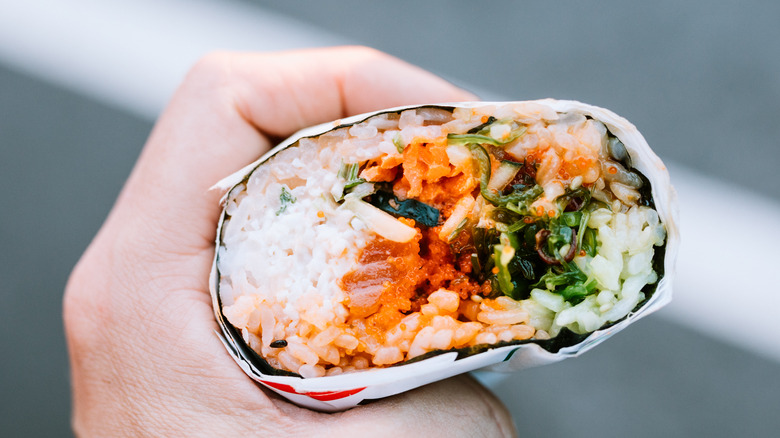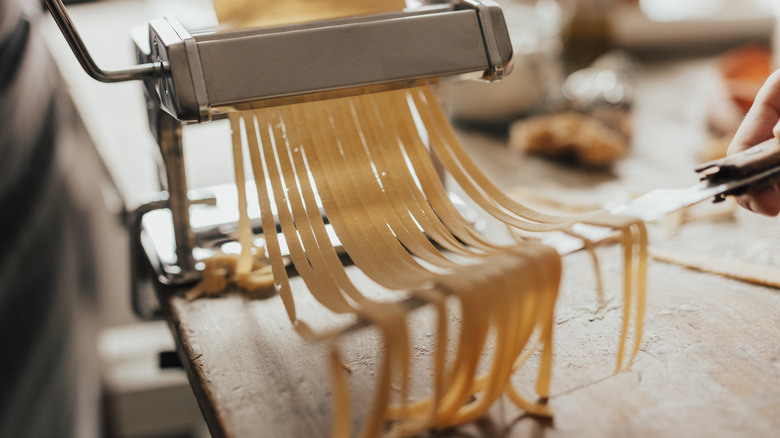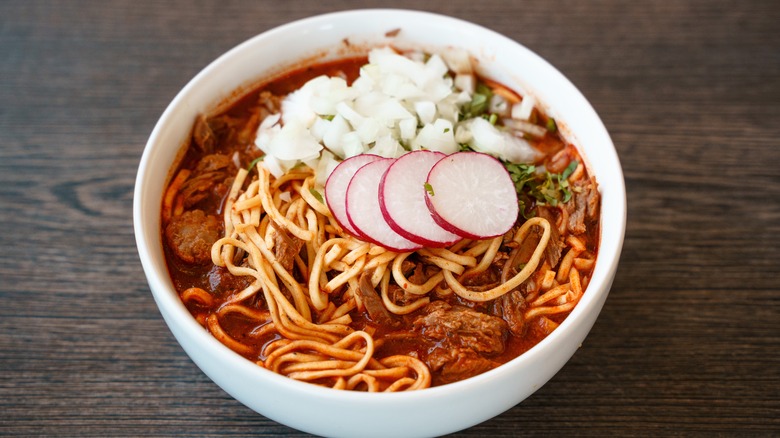How Fusion Cuisine Became So Popular In Restaurants Worldwide
If you've ever enjoyed a Reuben egg roll, a sushi burrito, or a slice of barbecue chicken pizza, then you know the prevalence of fusion cuisine in the U.S. and abroad. Much like other cultural touchstones, such as language, visual arts, music, and dance, cuisine is inherently influenced and altered as cultures come into contact. Agricultural products have been traded globally for millennia, and ideas about food preparation have been shared for just as long. Fusion has flourished, acknowledged or not, for a long time.
In a more modern sense, fusion cuisine refers to a very intentional — some might even say inorganic — melding of disparate foodways almost as much for the sake of doing it as for the expected delicious outcomes. A hallmark of the 1980s, modern fusion cuisine's popularity in the U.S. is often credited to one of the first celebrity chefs. Wolfgang Puck was the toast of Los Angeles' culinary scene with the innovative food he served at Spago, a legendary restaurant that many credit with putting fresh, inventive California cuisine on the map. His second restaurant, Chinois, continued to push boundaries as he married his French training with flavors culled from Asian cuisines and reflective of the large Asian diaspora in LA. As happens, the style quickly went from trendy to cliché as restaurants coast-to-coast got in on the action. Time-tested as it is, fusion cuisine didn't die off, but rather evolved, with its influence still evident to this day.
The long history of fusion
Though Puck gets credit for putting fusion cuisine center stage, the truth is we've been fusing cuisines, knowingly and not, for ages. One of the most trotted-out examples, especially for those with an imperious view of Western cultural exceptionalism, is spaghetti, or more broadly, noodles. While the starchy dish is a staple of Italian and other Western cuisines, most evidence points to its origin in what is now China. From there, noodles moved along trading corridors from Asia to the Middle East and into Europe, where they were eventually stirred into a sauce made from tomatoes, themselves plundered from the New World.
Of course, that isn't the only example of Chinese and Asian culinary influences being blended into other cuisines. At the end of the 19th century and the turn of the 20th, many immigrants from China made their way to Peru seeking work. Their food culture came along too, finding a happy home and adapting to local and readily available ingredients, quickly becoming one of the country's most popular cuisines, Chifa. Stir-fried lomo saltado, arroz chaufa (aka fried rice,) and tallarin con pollo are just a few of the dishes that reflect the fusion of Peruvian and Chinese tastes. Flowing in the opposite direction, Portuguese explorers and traders left their mark on Asian cuisines. One of the most well-known Japanese dishes, tempura, traces its descent from Iberians who brought the heretofore unknown art of batter-frying foods to the island nation.
What's next?
Today, though it does not occupy the chic pedestal it once did, fusion cuisine is still ubiquitous. In fact, it has so fully integrated into our culture as to be a bit commonplace these days. We don't really bat an eye anymore when we see a taco stuffed with grilled short ribs and kimchi. Nor do we find it odd that birria is everywhere these days, from burgers to ramen. Globalization and the breakdown of cultural barriers do have their upsides.
Despite its common status in the culinary lexicon, fusion can still be haute cuisine. Take, for instance, the now-shuttered, but very much celebrated Passeroto restaurant, which had a three-year run in Chicago. Before the pandemic and concerns about running an ethical restaurant led chef Jennifer Kim to close the doors, it enmeshed the cuisines of Korea and Italy with a style and intelligence that impressed critics and diners alike. Kimchi pajeon was made with chickpea flour and dressed in mustard green pesto, while Korean fried chicken came coated in gochujang and Calabrian chiles.
Fusion will wax and wane and persist as it always has. There will be scads of misses where chefs confuse the novelty of mashing two cuisines together as an apt replacement for consideration of flavor. Yet, there will be transcendent moments of cultural coming-together that will make many culinary cognoscenti wonder why such fusion has never been attempted before. Of course, maybe it has.


